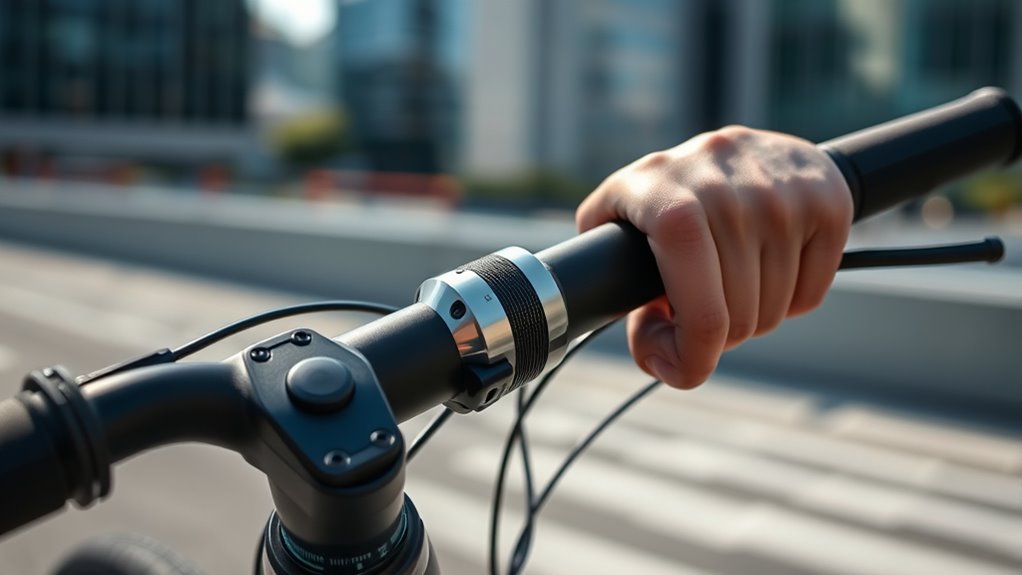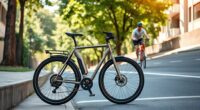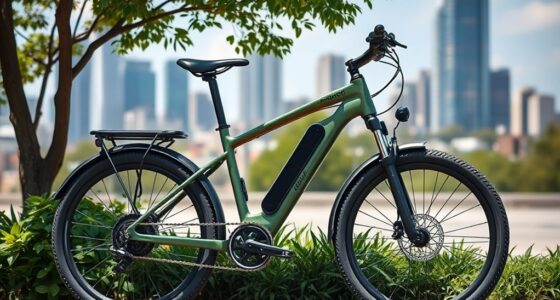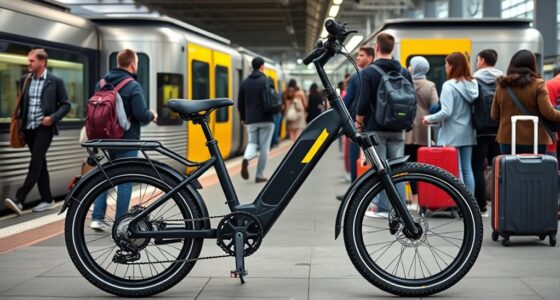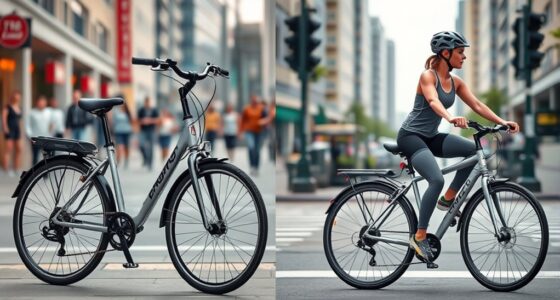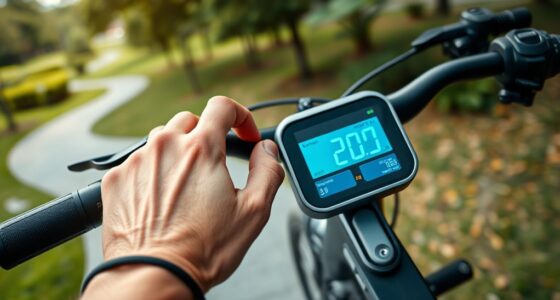Torque sensors make your commuter e-bike feel like magic by instantly adjusting motor assistance based on how hard you pedal. Instead of relying on fixed settings or cadence, they respond smoothly to your effort, creating a natural riding experience. This seamless support makes riding more intuitive and effortless, boosting confidence and comfort. If you keep exploring, you’ll discover how this technology truly transforms your daily commute into a smooth, personalized journey.
Key Takeaways
- Torque sensors adjust motor support in real-time based on pedaling force, creating a natural and intuitive riding experience.
- They enable seamless assistance, making the ride feel smooth and effortless, similar to traditional biking.
- By optimizing energy use, torque sensors extend battery range and improve overall efficiency.
- Instant data transmission ensures quick motor responses, enhancing ride stability and responsiveness.
- Overall, torque sensors transform e-bikes into smart, adaptive partners that feel almost magical to ride.
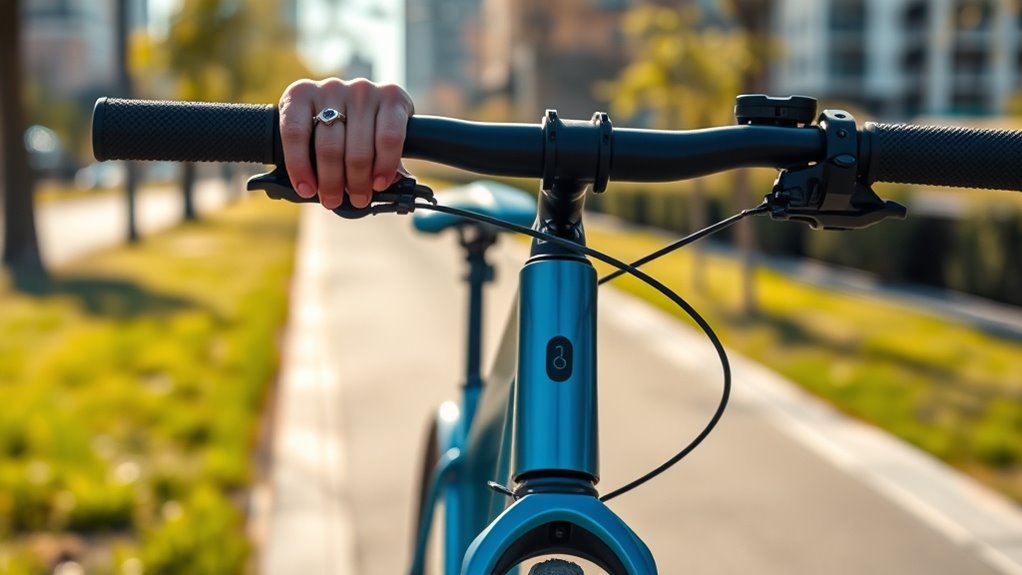
Have you ever wondered how e-bikes provide smooth and responsive assistance? The secret lies in the sophisticated way they detect and respond to your pedaling effort, especially through the use of torque sensors. Unlike basic cadence sensors that activate assistance at a fixed rate, torque sensors measure the force you’re applying to the pedals in real-time. This precise measurement allows the motor to deliver power exactly when you need it, creating a riding experience that feels natural and intuitive. When you push harder on the pedals, the motor responds instantly, ramping up support seamlessly. Conversely, as you ease up, the assistance tapers off smoothly, making your ride feel more like riding a traditional bike but with a helpful boost. This real-time responsiveness is what makes torque sensor-equipped e-bikes feel almost magical—they adapt to your effort so fluidly that it becomes effortless to maintain your desired speed and cadence. Robust safety measures are also critical in ensuring that these systems operate reliably under various conditions. One of the key benefits of this technology is its impact on battery efficiency. Since the motor only provides assistance proportional to your pedaling force, it uses energy more judiciously. You don’t waste power when you’re coasting or pedaling lightly; instead, assistance kicks in precisely when needed. This smart energy management extends your riding range, letting you go farther on a single charge. It also reduces unnecessary strain on the battery, which can prolong its lifespan over time. As a result, you get more miles out of each charge, making your commute more reliable and cost-effective. Motor integration plays a pivotal role in making this system work seamlessly. In a quality e-bike, the torque sensor is tightly integrated with the motor controller and the overall drive system. This integration ensures that data from the sensor is transmitted instantly to the motor, enabling immediate adjustments. The motor then responds with just the right amount of support, creating a smooth riding experience without jerks or lag. This tight coupling also helps keep the bike’s weight balanced and the ride stable, which is especially important for commuting. When your e-bike’s motor and sensor work in harmony, it feels like the bike is reading your mind—anticipating your needs and adjusting support so smoothly that you hardly notice the transition. This level of motor integration and sensor sensitivity elevates the riding experience, making your daily commute more enjoyable and less tiring. In essence, torque sensors transform your e-bike into a smart, responsive partner that adapts effortlessly to your pedaling style. By optimizing battery efficiency and ensuring seamless motor integration, they make riding feel natural and almost effortless. This advanced technology is what turns an ordinary e-bike into a truly extraordinary commuting companion.
Frequently Asked Questions
How Do Torque Sensors Differ From Cadence Sensors in E-Bikes?
You’ll notice torque sensors gauge your pedal effort, providing smooth, intuitive pedal assist with high sensor sensitivity. Unlike cadence sensors, which rely on pedal speed, torque sensors calibrate to your force, allowing precise power modulation. This results in a natural riding feel. As you pedal harder, the sensor responds instantly, adjusting assist levels seamlessly, making your ride more comfortable and responsive without abrupt changes.
Can Torque Sensors Improve Battery Life on E-Bikes?
Torque sensors can improve your e-bike’s battery life by enhancing battery efficiency through smarter power management. When you pedal harder, the sensor detects this increased effort and adjusts the motor assistance accordingly, reducing unnecessary power draw. This precise control means your battery lasts longer, giving you more riding time. So, with torque sensors, you benefit from better energy use, making your rides more efficient and extending your e-bike’s overall battery life.
Are Torque Sensors More Expensive Than Other E-Bike Sensors?
You’ll find that torque sensors are generally more expensive than other e-bike sensors, like cadence sensors, due to their complex design and precise measurement capabilities. However, they tend to offer better sensor longevity because they’re built to withstand frequent use and harsh conditions. While the initial cost comparison favors simpler sensors, investing in torque sensors can provide a more responsive and reliable riding experience over time.
Do Torque Sensors Require Special Maintenance or Calibration?
Think of torque sensors as the heart of your e-bike’s smooth ride. They do need some gentle attention—sensor calibration helps keep them accurate, and routine maintenance guarantees longevity. You might need to check connections or update firmware occasionally. Unlike simpler sensors, torque sensors demand a bit more care, but their responsiveness transforms your ride into a seamless experience, making every pedal stroke feel like magic.
How Quickly Do Torque Sensors Respond to Pedaling Changes?
You’ll notice that torque sensors respond almost instantly to pedaling dynamics, typically within milliseconds. This sensor responsiveness allows your e-bike to smoothly adjust assistance based on your pedaling effort, giving you a natural ride feel. As you pedal, the sensor constantly monitors your force, ensuring seamless power delivery that feels intuitive. So, whether you’re accelerating or adjusting your cadence, the sensor quickly adapts to keep your ride effortless and responsive.
Conclusion
With torque sensors, your e-bike becomes an extension of yourself, transforming every pedal stroke into a symphony of effortless power. They’re the silent magic behind smooth, intuitive rides that feel like gliding on air. As you navigate city streets or mountain trails, these sensors whisper your intentions to the motor, making each journey feel almost enchanted. Embrace this technology, and watch your ride become a seamless dance between human and machine—truly a marvel in motion.
